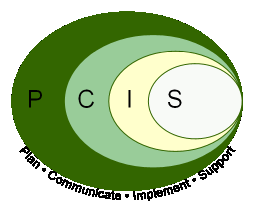|
The Wills-Way™ IT
Management Model

I am developing the Wills-Way™ IT Management
Model as a way to synthesis and synergize the diverse methodologies
and frameworks that influence my approach to IT management. The goal
of
the model
is to help smaller organizations make wise, efficient use of technology
to meet their business goals. I attempt to apply models and frameworks
designed for large companies but to adapt them to the unique needs
of small businesses. The model presented here represents best practices
from my own experiences, other professionals I have worked with, and
all the models I have studied.
The main premise of the model is that good
IT management derives from four primary domains: Plan, Communicate,
Implement, and Support.
Plan
Planning ranges from short-term project management to ensuring long-range
technology plans are in alignment with your business goals.
Communicate
I considered making “Communicate” the number one focus
of the model. Good communication is key to every aspect of IT management
from communicating the strategic plans to IT staff to communicating
changes to end users and to training users and IT staff on new technologies
in use.
Implement
Implementation means implementing whatever plan you developed. In the
case of long-range plans, implementation means carrying out the daily
operations to reach the long-range goals. It could also mean rolling
out a new server or writing a new piece of software.
Support
Support is what many people think of when they think of IT operations.
However, my point in making it the smallest circle in the model is
that sufficient time spent in the other domains can greatly reduce
the time spent in the Support domain. This is in line with Stephen
Covey’s “Time Management Matrix” from “The
Seven Habits of Highly Effective People.” Most of the other
domains are Quadrant II activities while the Support domain is clearly
a Quadrant I activity. Or, to quote Ben Franklin, “An ounce
of prevention is worth a pound of cure.”
The representation of the domains as progressively smaller ovals all
terminating at the same point is significant for a couple reasons.
- The relative sizes indicate the relative amounts of time you
need to spend in each domain.
- The ovals are roughly placed in timeline
fashion. Planning begins first but doesn’t end until the project
ends – though with less
time spent in that domain as time passes. Similar principles apply
to the other domains.
- Each subsequent domain exists within the confines
of the preceding domain. For example, you only support what you
implement.
|



